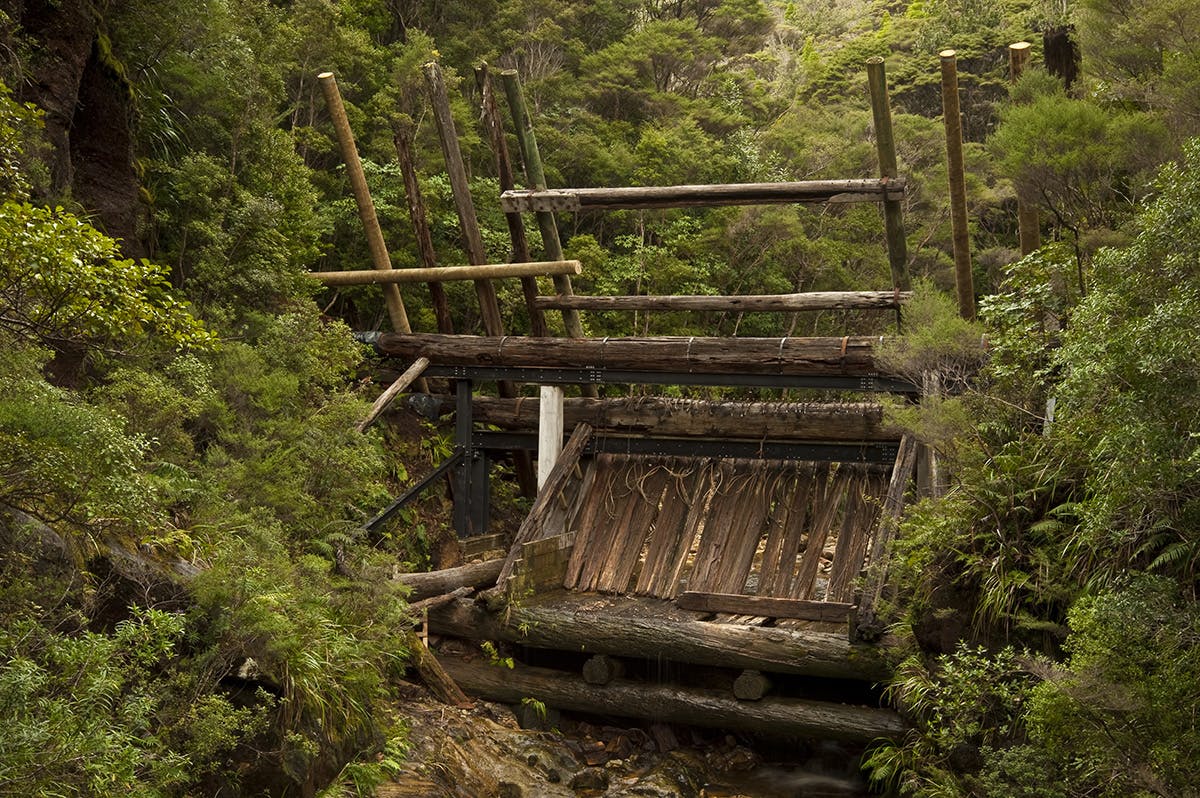Three places to see kauri driving dams
One pull of a wire and the dam is unleashed.
Down the steep valley sweep millions of litres of water, carrying tonnes of kauri logs to where they can be transported by boat or tramway to a mill.
Watching a driving dam in action must have been an awesome spectacle, provided you weren’t too close. Several people lost their lives in dam-induced floods, although a few miraculously survived, too.
Several dams in adjacent tributaries were often tripped at a predetermined time to increase the effectiveness of their combined power downstream. The process caused enormous destruction to the streams and was often wasteful, but nevertheless provided an ingenuous way of extracting timber from terrain too difficult by any other means.
Canadian lumberjacks bought the driving dam technology to New Zealand in the 1850s . Constructing a dam (sometimes known as a stringer dam or timber dam) was an exacting and skilled task, taking several months. Long logs, known as ‘stringers’, were wedged into rock or trenches cut into the banks, which with vertical ‘rafters’ served as the framework for the planks that formed the main dam wall. In the mouth of the dam, a clever gate consisted of planks hung from wires and held in place by the weight of the water against loosely held timber at the base. Such dams could take a year or more to fill, and would be released only when enough kauri had been dragged, hauled or felled into its waters. Various mechanisms, such as a simple steel pin, were used to hold the timber at the base of the gate in place and which could be remotely triggered using a wire or lever.
The beauty of the design meant the dam could be re-used, sometimes several times. No two dams were exactly alike: each varied according to the builder and the requirements of the topography.
All told, some 3000 driving dams once existed in New Zealand, with the last built during the late 1930s in what is now Kaimai-Mamaku Forest Park.
Gradually, the dams decayed and disappeared and now only a few remain; symbols of an extraordinary, if destructive, New Zealand enterprise.
Dancing Camp Kauri Dam, Coromandel Forest Park
New Zealand’s largest hut, Pinnacles, sits in the area once occupied by the huts and cookhouse of Dancing Camp during the 1920s. Nearby is the remains of the Dancing Camp Kauri Dam, built in 1924, one of the last of some 64 dams built in the Kauaeranga Valley after the First World War. Bert Collins held the contract for kauri milling in the area, which finally ceased in 1928. Over ensuing decades, the dam survived relatively intact but was deteriorating until DOC archaeologist Neville Ritchie led an authentic restoration of the dam in the mid-1990s, using kauri washed out during a flood. The dam now forms one of the main features of the Kauaeranga Kauri Trail, one of New Zealand’s best historic tramps.
Kaiaraara Kauri Dam, Great Barrier Island
Kauri millers stripped Great Barrier Island of virtually all its virgin kauri stands, excepting a small area surrounding the summit of Mt Hobson.
The island is the remnant of an old chain of volcanoes and some of the topography is steep, with incised streams. Six driving dams were built in the Kaiaraara Stream during the 1920s. Two remain, with the lower dam, reached after an hour’s tramp from Kaiaraara Hut, the most intact of any in the country.
Recent conservation work using steel girders and pine has shored up the dam. Although these materials lack the authenticity of the Dancing Camp dam restoration, they will prolong the life of the dam considerably. A platform gives a commanding view of the impressive structure.
The dam further up-valley is considerably smaller, with only one upright still in place.
Note, Kaiaraara dam has been destroyed. Visitors can still walk to the dam’s remains.
Waitakere Ranges, Auckland
Some 96 kauri dams once existed in the Waitakere Ranges, with milling lasting as late as the 1920s. Stringer dam remains exist at several places, with the most important at Piha, Bethells, Whatipu and Karekare. These were built between about 1900 and 1920. Just four families constructed 80 of these dams, showing how close-knit the timber industry was in those days.
Archaeologists Jack Diamond and Bruce Hayward did much to record the history of the timber industry in these ranges. During the 1920s, plans for more kauri milling in the Cascade Kauri area led to protests from locals concerned about preserving the bush, and their efforts eventually resulted in the formation of the Waitakere Ranges Centennial Memorial Park.








